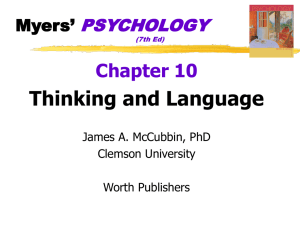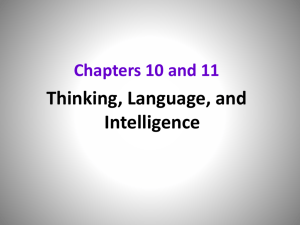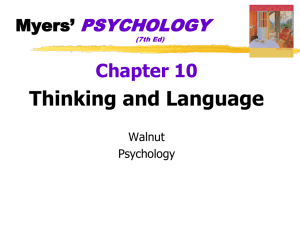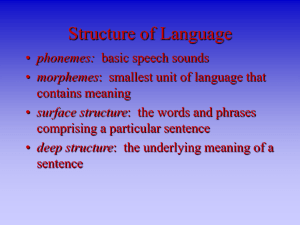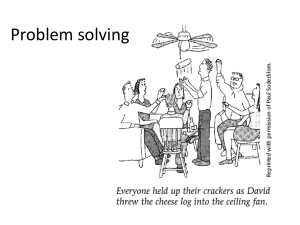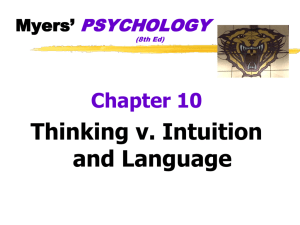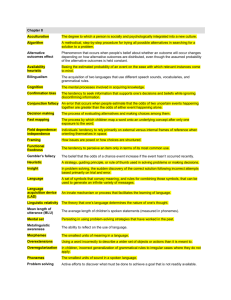for language?
advertisement
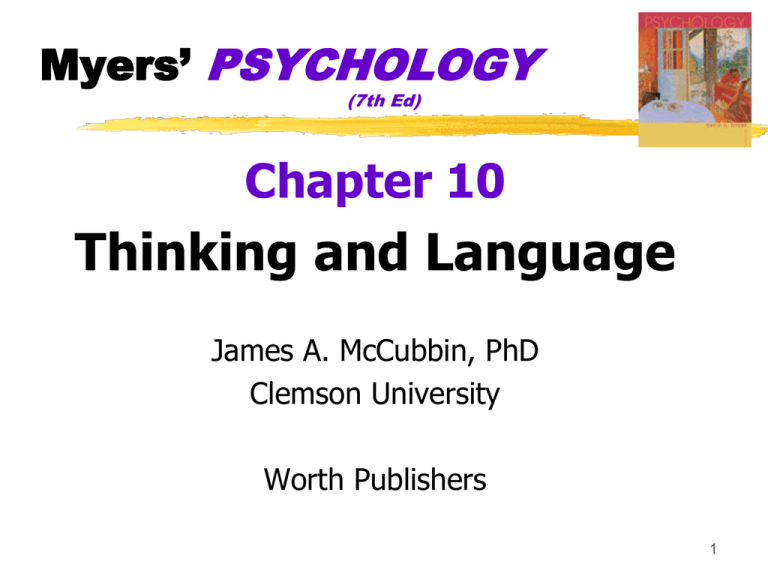
Myers’ PSYCHOLOGY (7th Ed) Chapter 10 Thinking and Language James A. McCubbin, PhD Clemson University Worth Publishers 1 Cognition Thinking mental activities associated w/ thinking, knowing, remembering, & communicating Affects … how we learn (Ch 8)… how we remember (Ch 9)… how we plan…Nurture (Ch 3 & 4)… how we dream (Ch 7)… how we use and learn language (this Ch)…. It is affected by neuropsych activity (Ch 2)… Cognition & cognitive processes will relate 2 to EVERY CHAPTER we do in this book! Cognitive Psychologists: The mental activities they research: concept formation: how we form ideas, schemas, heuristics,etc. problem solving: involves how we look at info, analyze it, & come up w/ solutions decision making judgment formation 3 Concept: mental grouping of similar objects, events, ideas, or people EX’s: cats, dogs, chairs, horses, law enforcement, etc.)….schemas Prototype: Mental image or best EX: of a category matching new items to the prototype provides a quick, easy way to include items in a category EX: Comparing feathered creatures to a prototypical bird, such as a robin (which is MOST ppl’s prototype for “bird” …not a penguin) 4 Algorithm Step-by-step methodical, logical rule or procedure that guarantees solving a particular problem -efficient, but can be time-consuming Heuristic: (mental short-cuts) simple thinking strategy that often allows us to make judgments & solve problems efficiently usually speedier than algorithms more error-prone than algorithms EX: You lose your keys...Which of these do you use to find them??? 5 Thinking Answer to “lost keys”: First heuristics (EX’s: looking in the last place you remember seeing them, the place you usually put them, along the path you took to come home, etc.) If these fail, you then fall back on algorithm & look every single place they could possibly be. (EX’s?) -------------------------------------------------------------------Unscramble SPLOYOCHYG Algorithm all 907,208 possible combinations Heuristic throw out all YY combinations other heuristics? 6 Insight sudden & often novel (?) realization of the solution to a problem (“Ah-HA!!” “Hey, wait…What about THIS?”) contrasts with strategy-based solutions Confirmation Bias: a major obstacle to problem solving tendency to search for information that confirms one’s preconceptions Fixation: stuck in one way of seeing something inability to see a problem from a new perspective impediment to problem solving 7 The Matchstick Problem How would you arrange six matches to form four equilateral triangles? 8 The Three-Jugs Problem Using jugs A, B, and C, with the capacities shown, how would you measure out the volumes indicated? 9 The Candle-Mounting Problem Using these materials, how would you mount the candle on a bulletin board? 10 5 ppl in a hospital: Each 1 has only 1 disease & each has a different disease. Each 1 occupies a separate room. Room #’s are 101 -105 1. Person w/ asthma in room 101 2. Ms. Jones has heart disease 3. Ms. Green is in Rm 105 4. Ms. Smith has tuberculosis 5. Woman w. mono is in Room 104 6. Ms. Thomas is in Rm 101 7. Ms. Smith is in 102 8. 1 of the patients, other than Ms. Anderson, has gall bladder disease. What disease does Ms. Anderson have & what 11 room is she in? CREATIVITY & THOUGHT: COMING UP W/ SOLUTIONS… (Read only…) Lipstick A private school in Washington recently was faced with a unique problem. A number of 12-year-old girls were beginning to use lipstick & would put it on in the bathroom… but after they put it on, they would press their lips to the mirror leaving dozens of little lip prints. Every night, the maintenance man would remove them & the next day, the girls would put them back. Finally the principal decided that something had to be done. She called all the girls to the bathroom and met them there with the maintenance man. She explained that all these lip prints were causing a major problem for the custodian who had to clean the mirrors every night. To demonstrate how difficult it had been to clean the mirrors, she asked the maintenance man to show the girls how much effort was required. He took out a long-handled squeegee, dipped it in the toilet, and cleaned the mirror with it. Since then, there have been no lip prints on the mirror. There 12 are teachers….and then there are educators... Thinking Mental Set tendency to approach a problem in a particular way…EX: a pencil? Matches? especially a way that has been successful in the past but may or may not be helpful in solving a new problem Functional Fixedness tendency to think of things only in terms of their usual functions impediment to problem solving Breaking set (or avoiding functional fixedness): coming up w/ novel ways to use items…”McGyver effect” 13 The Matchstick Problem Solution to the matchstick problem involves thinking outside the box…and not assuming limits like 2-D instead of 3-D Consider new ways…not fixed ways 14 The Three-Jugs Problem Solution: a) All seven problems can be solved by the equation shown in (a): B - A - 2C = desired volume. b) But simpler solutions exist for problems 6 and 7, such as A - C for problem 6. 15 The Candle-Mounting Problem Solving this problem requires recognizing that a box need not always serve as a container 16 Writing assignment: Pp. 392-393: Read “Risks—Do we fear the right things?” Summarize and explain the 4 influences on our intuitions about risks…..Give examples of each. 17 Heuristics: Some possible Causes of Faulty thinking! Representativeness Heuristic judging the likelihood of things in terms of how well they seem to represent, or match, particular prototypes may lead us to ignore other relevant info Availability Heuristic: 2 parts: 1) estimating the likelihood of events based on their availability in memory…relate to “recency effect” 2) if instances come readily to mind (perhaps because of their vividness…how it stands out), we presume such events are common EX: airplane crash = phobia…but what about cars? 18 Thinking Overconfidence tendency to be more confident than correct tendency to overestimate the accuracy of one’s beliefs & judgments Planning fallacy: when we are over-confident RE: time it will take us to do something… EX: Research paper? Studying? Framing: way an issue is posed; way it’s worded how an issue is framed can significantly affect decisions & judgments EX: What’s best way to market ground beef--as 25% fat or 75% lean? 19 Thinking Belief Bias: tendency for our pre-existing beliefs to distort logical reasoning sometimes invalid conclusions seem valid…or valid conclusions seem invalid (relates to “group-think” also…Ch. 18) Belief Perseverance clinging to one’s initial conceptions after the basis on which they were formed has been discredited 20 Artificial Intelligence (AI) designing & programming computer systems to… …do intelligent things …simulate human thought processes (parallel) intuitive reasoning learning understanding language (272 Baron’s) Computer Neural Networks computer circuits that mimic brain’s interconnected neural cells & perform tasks much like humans… learning to recognize visual patterns learning to recognize smells 21 Language Language our spoken, written, or gestured works & the way we combine them to communicate meaning Phoneme 1st bldg. block in a spoken language, the smallest distinctive sound unit EX: bat = b, a, t or that = th, a, t Morpheme photo = ph, o, t, o 2nd building block in a language, the smallest unit that carries meaning EX’s: I a bat or… -s = cat cats de- compose decompose may be a word or a part of a word (such as a prefix or suffix) Grammar: rules in a language that enables us to communicate w/ & understand others 22 Language Semantics the set of rules by which we derive meaning from morphemes, words, & sentences in a given language also, the study of meaning Includes connotation…if it has a positive or negative feel… determined or bull-headed ? Syntax the rules for combining words into grammatically sensible sentences in a given language apple red…or red apple? 23 Language We are all born to recognize speech sounds from all the world’s languages About when do we “switch” to the “home language”? Percentage able to discriminate Hindi t’s 100 90 80 70 60 50 40 30 20 10 0 Hindispeaking adults 6-8 months 8-10 months 10-12 months Infants from English-speaking homes Englishspeaking adults 24 Cooing: 1st…2-3 months: “Oooooooo…” Babbling Stage: begins about 3 - 4 months infant suddenly utters various sounds that are at 1st unrelated to the household language EX’s? Beginning to recognize sounds Sounds connected to own culture’s lang. by about 10 mos. 1-Word Stage: (about age 1 2) child speaks mostly in single words EX:’s? Inflection can = a sentence EX: “Doggy!” 2-Word Stg: (about age 2) speaks in mostly 2-word statements EX’s? kid is “getting” syntax…word order: EX: Engl. = noun + adj. But SP? FR? 25 Telegraphic Speech: Early speech stage in which the child speaks like a telegram-–“go car”--using mostly nouns & verbs & omitting “auxiliary” words Remember assimilation & accommodation? (Ch. 4) ------------------------- 3 theories RE: way kids devel. Lang.: Are based on the Heredity vs. Environment question: 1) Behaviorism/Skinner (learn w/ rewards/punish.) 2) Genetics/Chomsky (it is “hard-wired” in humans) 3) Cognitive/neuroscience (connections, etc…it’s BOTH) Lev Vygotsky: Kids learn to use words & solve problems by internalizing their culture’s lang., & relying on inner speech 26 Language (t-406) Summary of Language Development Month Stage (approximate) 4 Babbles many speech sounds 10 Babbling reveals households language. 12 One-word stage. 24 Two-word, telegraphic speech. 24+ Language develops rapidly into complete sentences. 27 Lang. Development Theories: Nature or nurture? 1) Skinner: It’s Behaviorism! We learn language from association, imitation, & operant conditioning’s reinforcement…learn from our environ./experiences! --little response = slower development 2) Noam Chomsky: It’s genetic! linguist; says there is some learning, but there is also innate mechanism for language (“hard-wiring”) -2 main ideas: wired for “universal grammar” & wired for grammatical rules --kids create their own sentences too fast for it to be just learning…and their own patterns… EX: Over-generalizing: adding –ed for past tense28 Noam Chomsky’s “hard-wire” Said genes language theories design the mechanisms for a language (heredity) , & experience (environment) activates them as it modifies the brain Are we “hardwired” for language? Is it innate? 29 3) Cognitive neuroscientists: Statistical learning: It’s BOTH! Shoots down Chomsky’s universal grammar, but supports tendency to follow & form grammatical rules: See infant’s learning (406) -those w/o access to language don’t develop left hemisphere can be limited Whorf”s hypothesis: Language determines the way we think…The interplay of thought & language EX: Hopi have no past tenses…so thinking in the past is limited (p. 409) Engl. vs. Japan.? = individualistic vs. collectivist soc.? Most now say language shapes or influences how we think… not determines… Lev Vygotsky fits here!! Kids learn to use words & solve problems by internalizing their culture’s lang., & relying on inner speech 30 Linguistic Determinism (409) Whorf”s hypothesis: Language affects thinking which affects lang. which affects…. 31 New language learning gets harder w/ age Teach kids languages early for best results Language Percentage correct on grammar test 100 90 80 70 60 50 Native 3-7 8-10 11-15 Age at school Best age for 17-39 2nd language: 3 - 7 yrs. 32 Kids & language… How kids translate it into what they understand… (Read only) A Sunday school teacher asked her class, "What was Jesus' mother's name?“ Tammy answered, "Mary." The teacher then asked, "Who knows what Jesus' father's name was. Anthony said, "Verge." Confused, the teacher asked, "Where did you get that?" Anthony replied, "Well, you know, they are always talking about Verge n‘ Mary.'' 3-year-old Reese: "Our Father, Who does art in heaven, Harold is His name. Amen." One particular four-year-old prayed, "And forgive us our trash baskets as we forgive those who put trash in our baskets.“ 33 Amen…. Benefits of bi- & multilingual education: some doubt this, but studies have been done that do show mental advancement in those who speak more than one language early on w/o economic influences being a part (p. 410) Umpire signals in baseball came from the 1st deaf baseball player in 1892. It worked so well it spread to other sports… 34 Thinking w/o language: Mental practice (411): athletes, musicians, students show improvement using mental rehearsal… Walk yourself mentally thru the steps involved… …but not just “seeing” themselves get an “A”… 35 Interesting quick video! How to interpret body language... Up to 80% of human communication is thru NON-verbal communication! http://www.howcast.com/videos/106 08-How-To-Interpret-Body-Language 36 Inspired problemsolving: How a Swiss company solved the problem of “male spillage” in apublic urinals: Increased accuracy by 85%!! 37 Clever—even if totally wrong & given no points... 38 Animal Thinking & Language (communication) Bees tell other bees where to Direction of find nectar nectar source sources using a dance… The straight-line part of the dance points in the direction of a nectar source, relative to the sun 39 Animal Thinking & Language Gestured Communication: Our lang. probably came from gestures, which apes still use. Body lang. & other non-verbal messages are a large part of communication (60-80%?!) 40 Animal Thinking & Language Is this really language? Animals can use language & even a bit of syntax… But NOT to the extent humans can 41 H-O 10,2: Rational-Experiential Inventory (REI): Are you analytical/rational or intuitive/experiential? Reverse #’s for 1, 2, & 5 (1=5, 2=4, 3=3, 4=2, 5=1) then add all (keep actual score for 3 & 4) Rational Scale: Higher scores=more rational (5 – 25) Experiential scale: Add actual #’s for 6-10 (5 – 25, higher = more intuitive/experiential) 42 Forward I am heavy, but backward I am not. What am I? He has married many women, but has never been married. Who is he? How are a jeweler and a jailer alike? How many bricks does it take to complete a building made of brick? How many of each animal did Moses take on the ark? How many times can you subtract the number 5 from 25? Once. After the first calculation, you will be subtracting 5 from 20, then 5 from 15, and so on. How much dirt is in a hole 4 feet deep and 2 feet wide? There is no dirt in a hole. I am used to bat with, yet I never get a hit. I am near a ball, yet it is never thrown. What am I? Eyelashes. A farmer had seventeen sheep, all but nine died, how many did he have left? Nine. A father's child, a mother's child, yet no one's son. A girl or daughter. A man builds a house with all 4 sides facing south. A bear walks past the house. What color is the bear? White: the house is built directly on the North Pole. A man drove all the way from New York to San Francisco only to discover at the end of the trip that he had a flat tire from the very start. Yet his car was completely unaffected by it? How is this possible? Even if they are starving, natives living in the Arctic will never eat a penguin's egg. Why not? Penguins are native to Antarctica. I have a head like a cat. I have feet like at cat. But I am not a cat. What am I? A kitten. I know a word of letters three, Add two and fewer there will be. Few. If a rooster laid a brown egg and a white egg, what kind of chicks would hatch? None. Roosters don't lay eggs! If an egg came floating down the Green River, where did it come from? A chicken. If there are fifteen crows on a fence and the farmer shoots a third of them, how many crows are left? None. The rest of the crows flew away 43 1. A woman had two sons who were born on the same hour of the same day of the same year. But they were not twins. How could this be so? 2. Before Mount Everest was discovered, what was the highest mountain on Earth? 3. Before the days of motor cars, a man rode into town on his horse. He arrived on Friday, spent three days in town and left on Friday. How is that possible? 4. Big as a biscuit, deep as a cup, even a river can't fill it up. What is it? 5. Can a man legally marry his widow's sister in the state of California? 6. (Answers next slide, 2nd column) 44 1. 2. 3. 4. 5. 6. 7. 8. 9. 10. 11. 12. 13. 14. 15. 16. 17. 18. A ton A priest. The jeweler sells watches and the jailer watches cells Only one - the "last" one. Hint: Who? Once. After the first calculation, you will be subtracting 5 from 20, then 5 from 15, and so on. There is no dirt in a hole. Eyelashes. Nine. A girl or daughter. It was his spare tire. White, b/c at North Pole. Penguins are native to Antarctica. Few. None. Roosters don't lay eggs! A chicken None. The rest of the crows flew away when they heard the gunshot. Nine. 1. They were two of a set of triplets. 2. Mount Everest. 3. Hint: Can you guess the horse's name? 4. A kitchen strainer. 5. No, because he's dead. 45 46 Confirmation Bias: tendency to search for information that confirms one’s preconceptions 47
